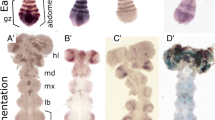Summary
The integument of an insect segment displays two distinct pattern features which are based on different properties of the constituent epidermal cells. Normally, the uniform orientation of epidermal cell polarities (“polarity pattern”) is strictly correlated with the sequence of differentiated cells (“differentiation pattern”). Here it is reported that in the integument of the cotton bug Dysdercus epidermal cells can adopt orientations that do not correlate with the pigmentation pattern and which are not compatible with the gradient model. The results indicate that different features of a composite pattern can be independently controlled.
Similar content being viewed by others
References
Bohn H (1970) Interkalare Regeneration und segmentale Gradienten bei den Extremitäten von Leucophaea-Larveti (Blattaria): I. Femur und Tibia. Wilhelm Roux's Arch 165:303–341
Bohn H (1974) Pattern reconstitution in abdominal segment of Leucophaea maderae (Blatteria). Nature (Lond) 248:608–609
Frankel J (1979) An analysis of cell-surface patterning in Tetrahymena. In: Subtelny S, Konigsberg IT (eds) Determinants of spatial organization. 37th Symposium of the Society for Developmental Biology, 1978. Academic Press, New York, pp 215–246
Frankel J, Jenkins LM (1979) A mutant of Tetrahymena thermophila with a partial mirror-image duplication of cell surface pattern: II. Nature of genic control. J Embryol Exp Morphol 49:203–227
Gubb D (1985) Pattern formation during development and the design of the adult cuticle in Drosophila. In: Balls M, Bownes M (eds) Metamorphosis. 8th Symposium of the British Society for Development Biology, Clarendon, Oxford
Gubb D, Garcia-Bellido A (1982) A genetic analysis of the determination of cuticular polarity during development in Drosophila melanogaster. J Embryol Exp Morphol 68:37–57
Held LI, Duarte CM, Derakhshanian K (1986) Extra tarsal joints and abnormal cuticular polarities in various mutants of Drosophila melanogaster. Wilhelm Roux's Arch 195:145–157
Hollweg G (1972) Eine neue Farbmuster-Mutante „white“ der roten Baumwollwanze Dysdercus intermedius Dist. (Heteroptera, Pyrrhocoridae). Biol Zentralbl 91:545–556
Jerka-Dziadosz M, Frankel J (1979) A mutant of Tetrahymena thermophila with a partial mirror-image duplication of cell surface pattern. J Embryol Exp Morphol 49:167–202
Lawrence PA (1974) Cell movement during pattern regulation in Oncepeltus. Nature (Lond) 248:609–610
Lawrence PA, Crick FHC, Munro M (1972) A gradient of positional information in an insect, Rhodnius. J Cell Sci 11:815–853
Locke M (1966) The cuticular pattern in an insect: the behaviour of grafts in segmented appendages. J Insect Physiol 12:397–402
Locke M (1967) The development of patterns in the integument of insects. Adv Morphogen 6:33–88
Marcus W (1962) Untersuchungen über die Polarität der Rumpfhaut von Schmetterlingen. Wilhelm Roux's Arch Entwicklungsmech 154:56–102
Meinhardt H, Gierer A (1980) Generation and regeneration of sequence of structures during morphogenesis. J Theor Biol 85:429–450
Mittenthal JE (1979) A model for the genetic control of differential adhesion in insect epidermis. J Theor Biol 81:129–149
Mittenthal JE (1981) The rule of normal neighbors: A hypothesis for morphogenetic pattern regulation. Dev Biol 88:15–26
Mittenthal JE, Mazo RM (1983) A model for shape generation by strain and cell-cell adhesion in the epithelium of an arthropod leg sement. J Theor Biol 100:443–483
Nardi JB, Kafatos FJ (1976a) Polarity and gradients in lepidopteran wing epidermis: I. Changes in graft polarity, form, and cell density accompanying transpositions and reorientations. J Embryol Exp Morphol 36:469–487
Nardi JB, Kafatos FC (1976b) Polarity and gradients in lepidopteran wing epidermis: II. The differential adhesiveness model: gradient of a non-diffusible cell surface parameter. J Embryol Exp Morphol 36:489–512
Nübler-Jung K (1974) Cell migration during pattern preconstitution in the insect segment (Dysdercus intermedius Dist., Heteroptera). Nature 248:610–611
Nübler-Jung K (1977) Pattern stability in the insect segment. I. Pattern reconstitution by intercalary regeneration and cell sorting in Dysdercus intermedius Dist. Wilhelm Roux's Arch 183:17–40
Nübler-Jung K (1979) Pattern stability in the insect segment: II. The intersegmental region. Wilhelm Roux's Arch 186:211–233
Nübler-Jung K (1987) Insect epidermis: disturbance of supracellular tissue polarity does not prevent the expression of cell polarity. Roux's Arch Dev Biol 196:286–289
Nübler-Jung K, Bonitz R, Sonnenschein M (1987) Cell polarity during wound healing in an insect epidermis. Development (in press)
Sander K, Nübler-Jung K (1981) Polarity and gradients in insect development. In: Schweiger HG (ed) Springer, Berlin Heidelberg New York Tokyo, pp 497–506
Author information
Authors and Affiliations
Rights and permissions
About this article
Cite this article
Nübler-Jung, K., Grau, V. Pattern control in insect segments: superimposed features of the pattern may be subject to different control mechanisms. Roux's Arch Dev Biol 196, 290–294 (1987). https://doi.org/10.1007/BF00395952
Received:
Accepted:
Issue Date:
DOI: https://doi.org/10.1007/BF00395952




